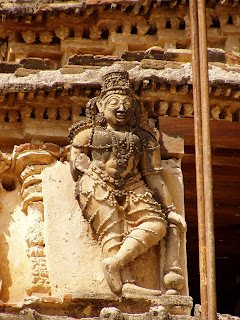Nagamangala Temple, Rahu-Ketu Dosa Nivaran, Nagamangala Direction, Dew Drops, Ravichander Rao
Having just come back from my vacation in India, and with my memory still fresh of the beautiful experiences, I could not hold back but research about the places I visited this time. Specially about a temple in Nagamangala - an ancient one believed to be over 1000 years old. The temple dedicated is to Lord Soumyakeshava (Vishnu), and is about 150 km from Bangalore, off of NH4 on the way towards Hassan.

(Lord Soumyakeshava - presiding diety at Nagamangala)
Ancient temples are generally associated folklores or have some mysticism surrounding them. This helps in kindering desire in some to explore the place and in some to seek the blessings to solve their problem or bring good luck. It is believed that this temple solves the Rahu-Ketu dosha (astrological significance) and removes any blockade that is currently affecting someone. The temple was built by Hoysala around 12th century and carries their characteristics such as a star shaped base around a central pillared hall. Later, the Vijaynagara kings added "Garuda sthumb" to the temple. The central hall has an intricately carved dome - Mandala, which has intricately carved Adhi Shesha and 108 Shankus (Counches). It is amazing to see how no two Shankus look alike. The Adhi Shesha sitting on a big Shanku which appears as if it is placed on heap of 108 Shanku, is a unique feature and is believed that no where in the world you find this particular form.
(Mandala - In the center Adhi Shesha wraps around big Shanku. Surrounding it is 108 Shankus)
During the course of over 800 years, the temple seems to have suffered a lot of neglect. The dieties on the main gopuram leading towards the central hall are crumbling. The sculptures carved on the stones are getting worn out. Importantly, a piece of history is getting lost because of the neglect and lack of attention from the government.
 (A diety on the main Gopuram)
(A diety on the main Gopuram)But all doesn't seem to have been lost. Some form of restoration work has already been started on the Gopuram, and there is also a plan to restore the Garuda Sthamb. All of this would not been possible merely by the government's help. Some people have already come forward, and helping restore this beautiful historical monument. Hopefully the next time we see the temple, it would have been restored to its old glory - if not completely then at least to somewhat extent.
If you wish to find more about the temple, please do contact the temple priest Sri Thiru Narayana Bhattar at:
Sri Sowmiya Keshava Temple. Nagamangala Post, Nagamangala Taluk, Mandya District, Karnataka, India. Pin: 571432. Cellphone: 9448-750603, Landline: (082)-34286529. (Thanks to Seshadri for the phone numbers.)
